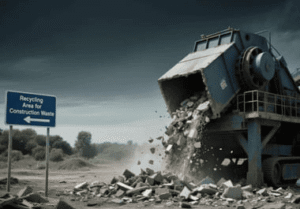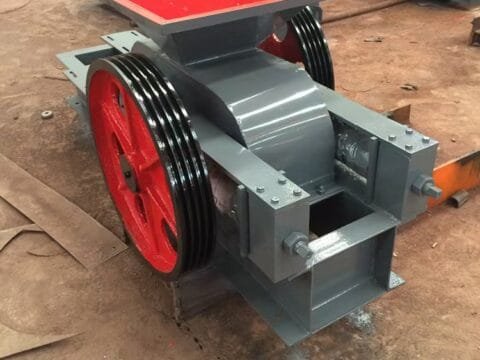
How to crack the problem of construction waste disposal in small districts? The Solution
“The recent renovation of the bricks, concrete piled up in the corner of the neighborhood for half a month, the property said that the removal fee is too expensive, how can we do?” This message triggered hundreds of discussions in a homeowners’ group. With the acceleration of urban renewal, the average annual production of construction waste of more than 8 million tons, of which the residential district decoration waste accounted for 35%. These wastes mixed with steel, wood and plastic not only encroach on public space, but also may cause soil pollution due to illegal dumping.

I. Current situation and challenges of construction waste disposal in neighborhoods
2023 data show that 87% of the city’s residential neighborhoods have construction waste retention problems. The reason for this is that the “three no’s dilemma” is particularly prominent:
No dedicated space: more than 60% of the neighborhoods have not set up a temporary storage area for classification.
No standardized process: property owners mostly use open-air piling + irregular removal mode
No cost advantage: traditional landfill disposal costs 80-120 yuan per ton.
A brand property manager has calculated an account: 20-story residential building renovation peak, a single day of construction waste removal costs more than 2,000 yuan. In order to save money, some properties acquiesce to the owners of the broken bricks mixed into the domestic waste, resulting in waste classification and transportation vehicles have been rejected many times.
Second, the three core pain points of construction waste disposal
1. Classification problems
Construction waste contains concrete (40%), wood (25%), metal (15%) and other eight types of materials. A pilot in a district showed that the resource utilization rate of unclassified waste is less than 20%, while it can be increased to 65% after classification.

2. Transportation regulatory loopholes
Despite the establishment of a record-keeping system for construction waste transporters, there are still “black trucks” dumping at night. 60% of the 27 cases of illegal dumping detected in 2023 came from neighborhood renovation waste.
3. Insufficient terminal treatment capacity
The city has three existing construction waste resource treatment plants with an annual capacity of only 1.5 million tons. This means that more than 80% of the waste still needs to be landfilled, which is an obvious gap with the requirement of the Ministry of Housing and Construction that the resource utilization rate should reach 50% by 2025.
Third, the whole analysis of scientific treatment strategy
Policy traction: government-property-owner tripartite linkage
The “Construction Waste Management Regulations” implemented in 2024 clearly stipulates:
Newly built communities must be equipped with ≥ 50 square meters of construction waste storage area
Property owners are required to publicize the qualifications and charges of transportation companies.
owners of illegal dumping maximum fine of 5,000 yuan
A community innovation launched a “green account” system: owners of the correct classification can accumulate points, exchange property fee discounts, within three months the participation rate of 72%.
Technology Enablement: From Sloppy Piling to Precise Treatment
Mobile crushing equipment: in the pilot project, the vehicle-mounted crusher can complete the crushing of concrete blocks directly in the community, with a conversion rate of 90%!

Intelligent identification system: AI cameras are introduced in the new district to automatically identify the composition of waste and generate a disposal plan
Online booking platform: “Yong Yiqing” small program to achieve 30-minute response to the removal trucks
Economic leverage: let the environmental protection generate revenue
recycled aggregate for crushed concrete is sold at RMB 45/ton.
Scrap steel bar recycling price of 2800 yuan / ton
Wood crushed material can be used for biomass power plants
A property company reduces its annual waste disposal expenditure by 41% through resource treatment and also receives 120,000 RMB in government subsidies for circular economy.
IV. Successful Cases: See how these three neighborhoods broke the mold
Case 1: A high-end community
set up intelligent sorting bins with weighing sensors
Signed a yearly recycling agreement with Guangxi Jiaotou Building Materials
Decoration waste detention time shortened to 48 hours
Case 2: Renovation of an old neighborhood
Utilizing abandoned carports to convert closed temporary storage points
Introduced community volunteers as “environmental protection supervisors”.
Monthly transportation volume decreased by 37%.
Case 3: New District Talent Apartments
Implemented a renovation deposit system (RMB 2,000/household)
Established a material sharing platform, and the reuse rate of residual materials reached 18%
Awarded “Waste-free District” demonstration site
V. Future Trend: Intellectualization and Industrial Synergy
A big data monitoring platform for construction waste is being prepared to track the whole process from the neighborhood to the treatment plant in real time. At the same time, cement and other enterprises plan to invest 360 million yuan to build a new resource base, is expected to 2025 can absorb 60% of the city’s construction waste.
The head of an environmental protection enterprise revealed, “We are testing the processing of broken glass into permeable bricks, a material particularly suited to Nanning’s rainy climate.” With the “14th Five-Year” Circular Economy Development Plan, construction waste is being transformed from “urban baggage” to “green minerals”.




